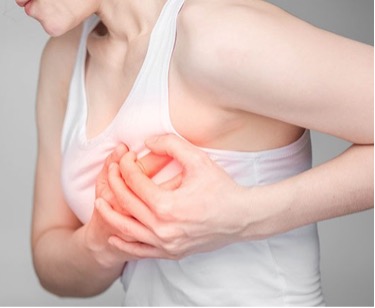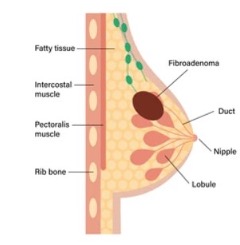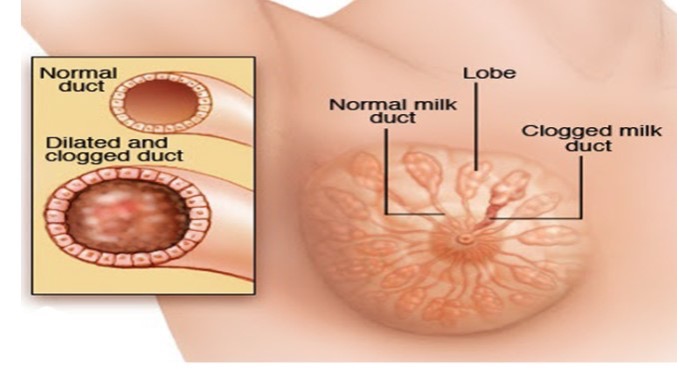Breast Diseases
Diagnosis and Treatment of Breast Diseases
The breast is an organ that changes from birth to the end of life. During puberty, with the eggs starting to work, estrogen and progesterone hormones are secreted and the breast begins to grow. During and after pregnancy, the breast continues to grow, prepares to give milk, and helps the baby to feed by producing milk. It shrinks again after breastfeeding. After menopause, the breast becomes smaller and the breast tissue begins to be replaced by adipose tissue.

IMAGE: Lobe and lobule structure of the breast
The breast, which is the symbol of motherhood and femininity, is under the influence of a total of 7 hormones. Stress, extreme fatigue, changes in nutrition, climate and environment cause differences in the levels of these hormones in the blood and thus changes in the breast.
There are benign and malignant diseases of the breast;
Benign diseases of the breast; Changes in the blood level of hormones affecting the breast cause fibrocystic structures in the breast. These occur in almost every woman at some point in her life.

IMAGE: Mastalgia
Cysts may ocur with symptoms such as breast swelling, edema, soreness and a mass with unclear borders, and it is more common in women aged 30-50. The best method of detecting these cysts is ultrasonography. They may be in one or both breasts. They mostly disappear after menopause. The presence of these masses causes fear due to the doubt of breast cancer in women. Simple breast cysts do not require drainage or surgical treatment. Women should be followed in regular intervals.
What Are the Symptoms of a Breast Cyst?
- A palpable mass, usually with indistinct borders, rarely smooth-sided, slippery, round or oval,
- When squeezed, Very rarely, gray-green discharge from the nipple · Pain or tenderness in the area where the mass is located,
- Increase in mass size or breast sensitivity, especially before menstruation,
- After the menstrual period, the mass size may decrease and the sensitivity of the breast may decrease.
Is Fibrocystic Breast Change a Disease?
- Fibrocystic breast change is not a disease and has nothing to do with cancer. It is more common in women who have menstrual irregularity, who are overtired, under stress, who are obese, who use cigarettes and anti-depressants, and who are in the transition period (peri-menopause). Breast swelling, pain, tenderness, palpable mass are the most common symptoms.
- Women can be followed up with ultrasonography every 6 months.
What is Fibroadenoma?
It is the most common benign tumor of the breast. It is usually seen in women between the ages of 15-35, it can rarely occur in older ages.

IMAGE: Fibroadenoma
Palpable fibroadenomas are well-circumscribed, round or oval masses that can move easily. The nonpalpable ones are similarly noticed on ultrasonography. They can occur in both breasts. Although the cause of its occurrence is unknown, it is thought to be related to reproductive hormones. Fibroadenomas are checked every 6 months by ultrasonography, biopsy and removal are recommended for those with a diameter of more than 3 cm, rapidly growing and deforming. They are not likely to turn into cancer.
What is Ductal Ectasia?
Ductal Ectasia is the widening of the milk ducts located behind the nipple, obstruction of the duct with fluid, sometimes a white appearance on nipple and a light-colored discharge coming from the nipple.
It is usually seen in women between the ages of 45-55.

- The reason for its occurance is not known exactly.
- Mostly, no treatment is required.
What is Fat Necrosis?
- Although it is not cancer, it is a breast change that is very similar to breast cancer in terms of signs and symptoms.
- The reason for its formation is traumas or infections due to impact, hitting in the breast tissue.
- What is a hamartoma?
- It is a benign breast tumor that occurs as a result of excessive growth and proliferation of cells in the breast tissue. The average age of onset is 45. It is rarely seen in young women.
- For diagnosis, mammography, ultrasonography and biopsy should be performed. If they overgrow and cause pain, they are surgically removed.
What is Intraductal Papilloma?
- They are small and benign tumors that develop in the ducts that carry milk in the breast. It is most common in middle-aged (35-55 years) women.
- They may cause a light-colored or bloody discharge from the nipple and a palpable mass when enlarged.
- In treatment, surgical method is applied to remove papillomas with surrounding healthy tissues. Cancer risk is determined by biopsy, if there is a sign of cancer, additional treatment is applied.
What is Lipoma?
- They are slow-growing, soft and mobile benign tumors that develop from fat tissues in the body, are located just under the skin or in the breast. These glands can occur in any body region containing adipose tissue. It is usually detected between the ages of 40-60 and in obese women.
- They do not need to be removed unless they cause any complaints. If necessary, the treatment is done by surgical method.
What are Infections in the Breast (Mastitis)?
Infections such as mastitis, cellulitis or abscess are frequently seen in the breast. These ailments in the breast can sometimes be confused with skin diseases and cancer.
Mastitis seen in lactating women (postpartum mastitis-puerperal mastitis): Bacteria entering through cracks in the nipple due to the suckling of the baby can easily cause infection and abscess in the breast in postpartum breastfeeding women. Breast redness, severe pain, fever, chills and weakness are seen. It is treated with antibiotics and cold compresses. It causes widespread abscess in the breast in some patients and may need to be drained surgically in the operating room environment.
Granulomatous Mastitis: It is a difficult-to-treat condition with an unknown cause, presenting with a mass, discharge, pain and tenderness in the breast. Physical examination and radiological findings mimic breast cancer. Therefore, a biopsy is required. Treatment methods include cortisone, evacuation of the abscess, and surgical cleaning.
Post-nipple mastitis: Symptoms include redness, pain, redness, tenderness, stiffness, and fever behind or around the nipple. It occurs mostly in smokers and women between 30-45 years old. Antibiotics and surgical drainage in the treatment
Are Nipple Discharge Always Dangerous?
If nipple discharges occur spontaneously, not when squeezed by hand, only come from a breast and a duct, if they are white or bloody, then this discharge should be considered important.
Malignant diseases of the breast
Breast Cancer
Breast cancer is the most common cancer in women. Breast cancer occurs as a result of cells becoming cancerous (unlimited and uncontrolled proliferation and growth).
Breast cancer, which is the most common cancer in women in the world, occurs during life in one of every 8-10 women. Although new treatment options are gradually increasing, success in breast cancer depends on early diagnosis. If breast cancer is diagnosed early, the chance of surviving the disease is 96 percent. For this reason, it is necessary to have early screening tests and to know the symptoms that will warn you early and make you consult a doctor.
Are you at risk?
Factors that increase the risk of breast cancer:
Age: The risk of breast cancer increases with age (especially after the age of 50).
Family history: The risk is increased in those with a family history of breast cancer and/or ovarian cancer, especially in a first-degree relative.
Menstruation onset and menopause age: Those who start menstruation at an early age (before 12 years old) and those who enter menopause late (after 50 years of age) increase the risk of breast cancer because the breast tissue is under the influence of estrogen hormone for a longer time.
Birth and breastfeeding: Not giving birth at all, giving birth late (after 30 years old), not breastfeeding increases the risk of breast cancer.
Hormone treatments: Uncontrolled hormone treatments after menopause increase the risk of breast cancer.
Weight: Being overweight and having a fatty diet increase the risk of breast cancer.
Genetics: Only 5-10 percent of breast cancers are due to a genetic disorder. The risk of breast cancer is high in someone with a family history of breast cancer at an early age, genetic testing is recommended.
Birth control pill: Not shown to increase the risk of breast cancer.
Diet: Avoiding food of animal origin, avoiding fatty foods, eating fruits and vegetables and maintaining an ideal weight reduce the risk.
Physical activity: It prevents weight gain and reduces the risk.
Alcohol: Its use increases the risk.
What are the symptoms?
The most common symptom of breast cancer is the feeling of a painless mass in the breast. Less common symptoms of breast cancer are nipple symptoms, including breast (for example, thickening, swelling, skin irritation or breakouts), discharge, abrasion, nipple tenderness or inversion. Early-stage breast cancers, which are the easiest to treat, typically show no symptoms. Therefore, it is very important for women to apply the recommended control programs for the early diagnosis of breast cancer. Diagnosing breast cancer at an early stage significantly increases the number of treatment options and the chances of successful treatment and survival.
What are the screening tests for early diagnosis?
There are three complementary methods recommended for early diagnosis:
Personal (Self-performed) breast examination: After 16 years of age, 7-10 days of menstruation. It is recommended to do it once a month between
Clinical breast examination (performed by the doctor): It is recommended to perform a breast examination by the doctor once every 1-3 years between the ages of 20-40, and annually from the age of 40.
Mammography: Annual mammography, starting from the age of 40, in women with standard risk, ensures the detection of breast cancer at an early stage.
How can breast cancer risk be reduced?
The risk of breast cancer can be reduced by making some changes in daily life. The risk can be reduced by being careful not to gain weight, doing sports, not eating foods high in fat, not smoking and not using alcohol, and not taking hormone replacement therapies after menopause. In patients with a family history and a high risk of genetically inherited breast cancer, one of the methods such as surgical removal of both breasts and replacement of prostheses, removal of the ovaries or drug therapy can be applied in patients with a genetic disorder as a result of genetic analysis.
How is the diagnosis made?
The diagnosis of breast cancer is made by imaging units and clinical examination findings. The pillar of imaging is the annual ultrasound and mammography. Mammography and breast ultrasound should be performed by a specialized breast radiologist.
Does biopsy have a negative effect on the progression of the disease?
Definitive diagnosis of cancer can only be reached as a result of examination of biopsy specimens in the pathology clinic. Without a biopsy, cancer can be suspected only by looking at the physical examination and screening tests, but a definitive diagnosis of cancer cannot be made and treatment cannot be started. The biopsy procedure does not have a negative effect on the disease. This procedure makes the definitive diagnosis.
How is breast cancer treated?
Depending on the stage of the disease and the characteristics of the tumor detected after pathological examination, surgery, chemotherapy, radiotherapy, hormonal therapy and biological treatments are used alone or in combination.
What is the place of surgical treatment in breast cancer?
Surgery is the most effective treatment in the early stage of breast cancer. Those who are offered surgical treatment in breast cancer constitute the patient group with the highest chance of survival when the disease is in the early stages and the cancerous tissue can be completely removed by surgery.
Should everyone diagnosed with breast cancer have their entire breast removed?
No. The size and location of the tumor and its appearance on the mammogram determine the extent of the surgery. If the tumor is small and in its initial stage, it may be sufficient to remove only a small part of the breast. In the same situation, there is a second option. This is the excision of the breast by protecting the skin and nipple and making a new breast in the same session.
What types of surgical treatments are used in breast cancer?
Breast cancer surgery is divided into two as breast-conserving surgery and other surgical methods. Breast-conserving surgery is a treatment performed by removing a part of the breast instead of the whole. Biopsy of axillary lymph nodes and postoperative radiation therapy may be required in this technique. Other surgical methods are the removal of the entire breast. While the whole breast is removed, the nipple and skin of the appropriate ones can be preserved and the inside can be completely emptied. In this last option, a new breast is made. In this method, axillary lymphatic biopsy can be performed if necessary.
How long does it take to reconstruct the breast with plastic surgery after breast surgery?
Reconstruction of the breast is done in two ways:
Breast Reconstruction in the Same Session: It is the making of a new breast for the operation where the breast was removed. This is the most commonly used method in recent years.
Performing Breast Reconstruction Later: It is performed for some patients whose cancer is very advanced and has reached the underarm lymph nodes. If radiotherapy is to be applied in these patients, a new breast is made 6 months after the end of the treatment.

IMAGE: Types of mammoplasty
PLEASE NOTE:
Do your breast self-exam on a monthly basis. If you experience a new swelling or sore, consult your doctor immediately.
After the age of forty, you should have a mammogram once a year.
Early diagnosis saves lives.
Have your regular follow-ups. Learn about breast cancer symptoms and risks. If you or your relatives have one or more of these, consult your doctor immediately.
Get Free Quote